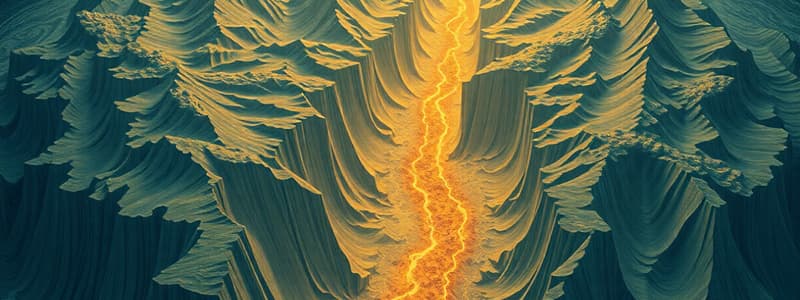Podcast
Questions and Answers
Which of the following best illustrates the difference between a globe and the Earth itself, according to the content?
Which of the following best illustrates the difference between a globe and the Earth itself, according to the content?
- A globe accurately represents the Earth's smooth surface, while the Earth has many plates that shift.
- A globe overemphasizes the number of connecting points between the hemispheres, unlike the Earth.
- A globe is a simplified model that doesn't fully represent the Earth's complex plate structure and movements. (correct)
- A globe incorrectly depicts the Earth's mountain ranges as indentations, while they are actually smooth.
The theory of plate tectonics is best described as:
The theory of plate tectonics is best described as:
- A speculative idea with little evidence to support the movement and interaction of Earth's plates.
- A proven scientific law explaining the Earth's fixed continents and unchanging seabed.
- A widely accepted scientific explanation, supported by substantial evidence, describing the movement and interaction of Earth's plates. (correct)
- An outdated hypothesis that has been disproven by modern geological findings.
What geological process is most likely to occur when two tectonic plates collide directly?
What geological process is most likely to occur when two tectonic plates collide directly?
- The sliding of one plate under another, resulting in a flat landscape.
- The formation of large mountain ranges. (correct)
- The formation of deep ocean trenches.
- The creation of a fault line with minimal seismic activity.
How does the content describe the movement of plates along a fault line?
How does the content describe the movement of plates along a fault line?
According to the content, what are the most likely consequences of the sudden release of energy built up along a fault line?
According to the content, what are the most likely consequences of the sudden release of energy built up along a fault line?
Flashcards
Plate Tectonics
Plate Tectonics
The theory explaining the movement of Earth's plates.
Plates
Plates
Chunks of land and seabed that make up Earth's surface.
Fault Lines
Fault Lines
Areas where two or more plates meet.
Tsunamis
Tsunamis
Signup and view all the flashcards
Earthquakes
Earthquakes
Signup and view all the flashcards
Study Notes
- Globes are relatively smooth and don't accurately represent the Earth's surface.
- Earth is made up of moving plates unlike a smooth globe.
Plate Tectonics
- Plate tectonics explains how Earth's plates move.
- Plate tectonics remains a theory due to the inability to directly observe the plates.
- Plates are always moving and changing.
- Plates can slide under each other, creating deep trenches.
- Plates can collide, forming mountain ranges.
- The Himalayas formed from the collision of the Indian and Asian plates.
- Continents usually make up their own plate.
Fault Lines
- Fault lines are points where two or more plates meet.
- Plates can move up, down, or rub against each other.
- Plates rubbing against each other can cause violent occurrences that release energy.
- The energy released from plates rubbing against each other causes earthquakes and tsunamis.
Earthquakes
- California is known for earthquakes due to fault lines like the San Andreas Fault.
- The 1906 San Francisco earthquake caused major destruction.
- Earthquakes release energy, causing shockwaves and tectonic readjustments.
- Thousands of earthquakes occur daily, but most are small.
- Large earthquakes occur when tectonic adjustments are too significant for minor readjustments.
Tsunamis
- Underwater earthquakes can cause tsunamis.
- Tsunamis are massive waves caused by energy transfer from earthquakes into water.
- Tsunamis are not tidal waves.
- Tsunami waves can reach 100 feet in height.
- States like Hawaii have tsunami evacuation procedures.
Studying That Suits You
Use AI to generate personalized quizzes and flashcards to suit your learning preferences.




